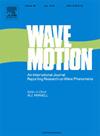通过块链的退化性推导 (2+1)-dimensional Yu-Toda-Sasa-Fukuyama 公式的弱相互作用块体
IF 2.1
3区 物理与天体物理
Q2 ACOUSTICS
引用次数: 0
摘要
本文介绍了将Yu-Toda-Sasa-Fukuyama方程的正常相互作用块链退化为弱相互作用块波的两种不同途径,这将丰富块链与弱相互作用块波之间的相关性。第一种途径是让 M 个速度相似的块状链的周期直接接近无穷大。第二种途径首先将 M 个正常相互作用的块状链转化为具有相似动态行为的弱相互作用块状链。然后,通过让它们的周期接近无穷大,产生 MM+12 弱相互作用的块状波。在这个方程中,弱相互作用块链之间的距离与 ln|t| 成正比,而弱相互作用块波之间的距离与 |t|3 成正比。这些发现将为波浪理论、海洋科学及相关学科的研究提供宝贵的理论启示。本文章由计算机程序翻译,如有差异,请以英文原文为准。
Derivation of weakly interacting lumps for the (2+1)-dimensional Yu–Toda–Sasa–Fukuyama equation via degeneracy of lump chains
This paper introduces two distinct pathways for degenerating normally interacting lump chains into weakly interacting lump waves for Yu–Toda–Sasa–Fukuyama equation, which will enrich the correlation between lump chains and weakly interacting lump waves. The first pathway involves letting the periods of similarly-velocity lump chains approach infinity directly. The second pathway first transforms normally interacting lump chains into weakly interacting lump chains with similar dynamic behaviors. Then, by allowing their periods to approach infinity, weakly interacting lump waves are produced. Distance between weakly interacting lump chains in this equation is proportional to , while between weakly interacting lump waves is proportional to . These findings will contribute valuable theoretical insights to the study of wave theory, ocean science and related disciplines.
求助全文
通过发布文献求助,成功后即可免费获取论文全文。
去求助
来源期刊

Wave Motion
物理-力学
CiteScore
4.10
自引率
8.30%
发文量
118
审稿时长
3 months
期刊介绍:
Wave Motion is devoted to the cross fertilization of ideas, and to stimulating interaction between workers in various research areas in which wave propagation phenomena play a dominant role. The description and analysis of wave propagation phenomena provides a unifying thread connecting diverse areas of engineering and the physical sciences such as acoustics, optics, geophysics, seismology, electromagnetic theory, solid and fluid mechanics.
The journal publishes papers on analytical, numerical and experimental methods. Papers that address fundamentally new topics in wave phenomena or develop wave propagation methods for solving direct and inverse problems are of interest to the journal.
 求助内容:
求助内容: 应助结果提醒方式:
应助结果提醒方式:


